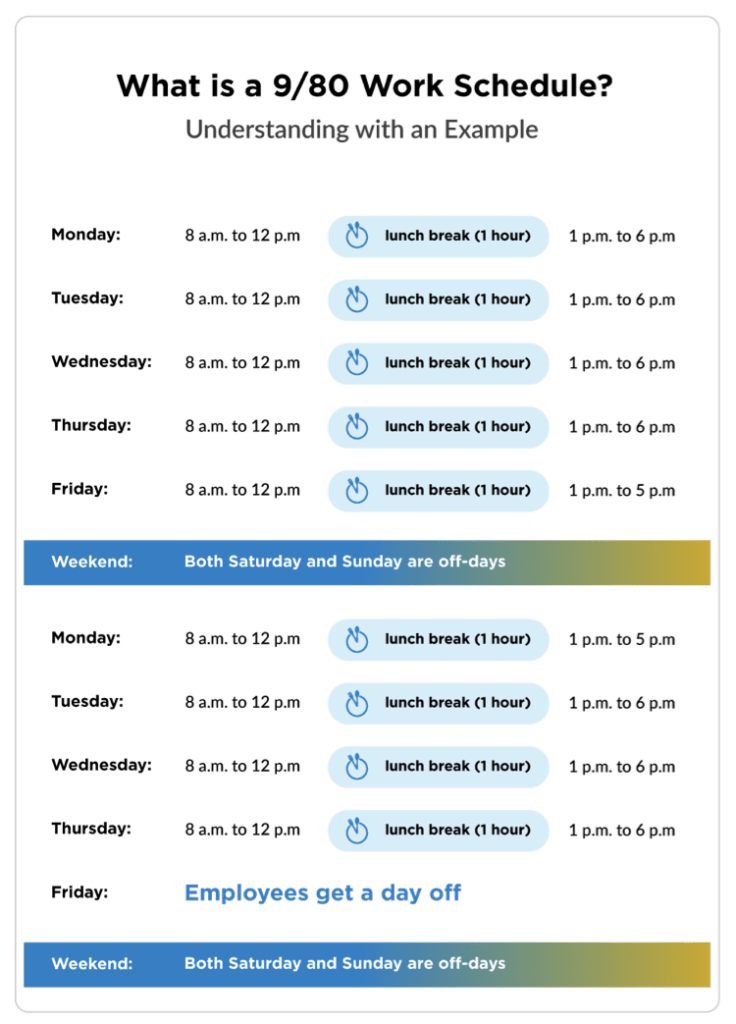Most organizations follow the standard 9 to 5 work schedule. However, many companies are now looking at alternatives and a 9/80 work schedule is one of them. This type of schedule involves long hours spread across two work-weeks. In this article, we will look at what is a 9/80 work schedule and what are the possible advantages and disadvantages of this work pattern.
First Things First… What Is a 9/80 Work Schedule?
A 9/80 work schedule basically comprises a total of eight nine-hour days, one eight-hour day, and one day off spread over a two-work week period. So, a 9/80 work schedule has employees working 80 hours over nine days (thus, the name: 9 days/80 hours) rather than the usual 10 days (assuming it’s a five-day workweek).
This allows the organization to give their employees an entire day off every other week. And since this is spread across two-workweeks, for salary calculations purposes, you have to apply the first half of the eight-hour workday to the first week and the second half to the next week.
Still, Confused? Let’s Simplify!
Let us understand this concept with an example. Assuming you have a 5 days work week and your workday starts at 8 a.m. with an hour lunch break, a 9/80 schedule will look something like as shown in the image.

What this essentially means is that, with this work schedule, your employees will work more on the weekdays and will then earn an additional off day every other Friday.
Benefits of 9/80 Work Schedule
The usual 9 to 5 schedule is comfortable as most of us are used to it. However, there sure are benefits of this new work schedule too. Let us look at some of the benefits of a 9/80 work schedule.
1. Increased Productivity
With fewer workdays and extra off days, businesses allow employees additional control over their work schedules. Which in turn will boost the employees’ morale and encourage them to work more and be more productive.
2. Higher Flexibility
Organizations can be smart about resource allocation and make the most of the 9/80 work schedule. The flexibility allows them to segregate the team and split them to ensure resource optimization. So, some of your employees can take Friday off while others might have Thursday as their week off. Thus, making the most of your resources to meet your organization’s goals.
3. Less Commute
Now, that the employees are going to the office for one less day, it reduces the hassles that come with traveling. Additionally, organizations can combine the 9/80 work schedule with the work from home model. Wherein the working hours will still be 9 hours but now the employee will work from home. However, the catch is to ensure they are work from home ready – in terms of infrastructure and other factors.
4. Higher Employee Satisfaction
Your employees are traveling less, have a flexible work schedules and are saving on traveling cost and time while enjoying a much better work-life balance. What does this mean? Well, all these positive things point to higher employee satisfaction. And let’s not forget – when the employees are happy, they tend to be more productive and that is great for the overall culture of the teams and company.
5. More Customer Satisfaction
When your employees are happy and satisfied this will also reflect in your customer satisfaction metrics. Imagine a customer service agent who has been stuck in traffic and is frustrated because he reached the office late. Now, when this agent gets on a customer call might show signs of irritation that will impact the quality of conversation and thus, the customer experience. Now, an agent who is well-rested, is happy will have a much better and pleasant engagement with the customer.
Disadvantages of 9/80 Work Schedule
Let us now look at some of the potential pitfalls of a 9/90 work schedule that one should consider before making the decision.
1. Leave Policy
Implementing this schedule might require you to rethink and restructure your leave policy. For instance, sick leave will now be for 9 hours rather than the usual 8 hours. So, while distributing your sick leave hours (usually 72 hours), you might need to re-jiggle things.
2. Resource Management – Insufficient Staff
This is particularly more concerning for smaller businesses. You do not want the majority of your staff to have their day off on Friday or Monday. Thus, care must be taken while splitting the team to ensure a five-day working situation. However, that might bring its own challenges of managing who gets the additional day off and when.
3. Implementation Hassles
Letting the employees adjust to the new 9/80 work schedule can be tricky. As with a 9-hour workday, they would either have to come early or stay till late. Which will require some adjusting on their part and can hamper their commitments and schedule. Thus, making them skeptical about the idea.
4. Overtime Issues
You might need to keep a check on the overtime hours. As employees who used to leave work at say 5 p.m. earlier and were used to completing their tasks by that time might now, start a new project/assignment to fill that additional hour. This might stretch things further and lead to overtime. If this is a rare occurrence, then it’s fine. However, if it becomes more frequent then that will increase your expenses in the long run.
In a Nutshell
There sure are many benefits of having a 9/80 work schedule. However, it all comes down to your unique business requirements. A company where leave policies are not structured properly or business functions where teams need to be present at a similar time or where there might be overtime issues or industries that have higher customer inflow during certain hours might rethink this approach to working. Having said that, with the right policies and technology in place, you can make it work to your advantage – it’s just a matter of understanding your business needs, customer, and employee needs while working towards the goals.

